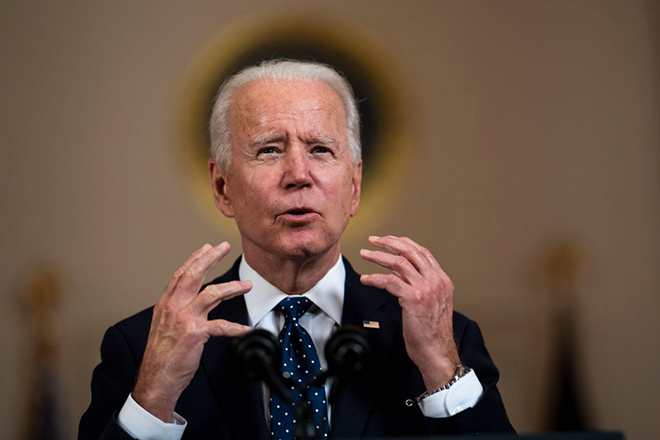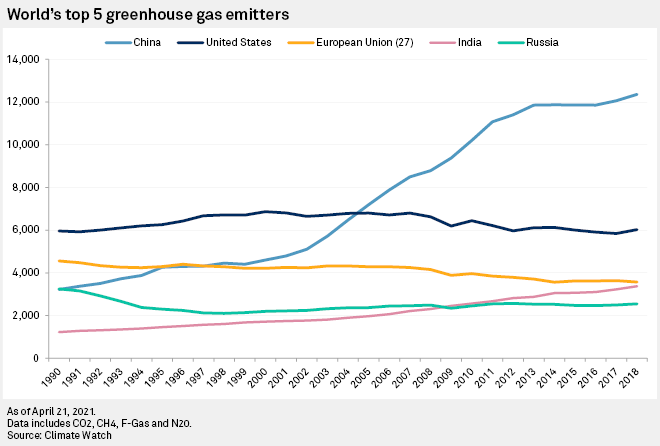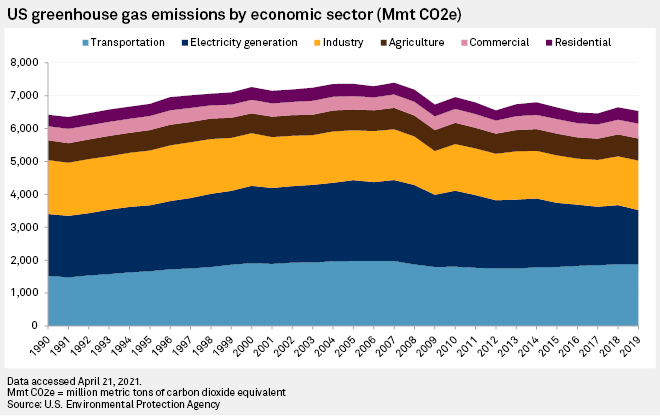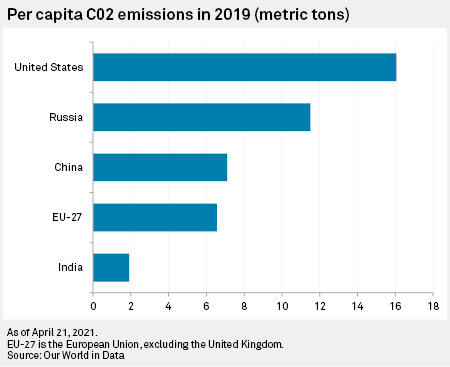
U.S. President Joe Biden is hosting a two-day climate summit with world leaders on April 22-23, 2021. |
The U.S. will commit to reducing economywide greenhouse gas emissions by 50% to 52% from 2005 levels by 2030 as part of its renewed membership in the global Paris Agreement on climate change, senior White House officials announced late April 21.
Biden will formally announce the pledge on April 22 at the start of a two-day White House climate summit attended virtually by dozens of world leaders, including President Xi Jinping of China, Canadian Prime Minister Justin Trudeau, German Chancellor Angela Merkel, Indian Prime Minister Narendra Modi, and European Commission President Ursula von der Leyen.
The new U.S. nationally determined contribution, or NDC, is aimed at limiting global warming to 1.5 degrees C above pre-industrial levels by the end of the century, a target that climate scientists warn must be met to avoid catastrophic climate shocks. The pledge is part of the president's recommitment to the Paris Agreement, a "bottom-up" international accord that relies on signatories to voluntarily strengthen their domestic climate policies as low-carbon technologies and climate finance tools continue to improve.
It comes as parties to the Paris Agreement are scheduled to convene in Glasgow, Scotland, in November to submit enhanced NDCs for 2030. The European Union, for example, cemented a deal this week that aims to slash the bloc's emissions 55% by 2030 measured against 1990 levels.

Under former President Barack Obama, the U.S. submitted an initial NDC to cut the nation's greenhouse gas footprint between 26% and 28% by 2025 relative to 2005 levels. The U.S. power sector has already exceeded those goals, but emissions from the nation's transportation sector — now its largest source of planet-warming emissions — are still rising.
On a call with reporters late April 21, senior Biden administration officials stressed that the new NDC will not include sector-by-sector emission reduction targets. The officials also declined to say whether the White House views Biden's $2 trillion infrastructure plan, which calls for $100 billion in power infrastructure spending, as essential to achieving the U.S.'s heightened climate ambition. The huge spending package is part of Biden's goal to decarbonize the U.S. electric grid by 2035, but it faces uncertain odds in the narrowly divided U.S. Congress.
"We see multiple paths to reaching this goal," one senior official said. "The United States' federal and sub-national governments have many tools available to work with civil society and the private sector, mobilizing investment to meet these goals while supporting a strong economy."

Officials on the call also pointed to concrete actions Biden has already taken, such as issuing an executive order outlining a timetable to develop a regulatory approach for curbing methane emissions from U.S. oil and gas facilities. Due to methane's relatively high but short-lived warming potential compared to carbon dioxide emissions, regulations targeting the pollutant can serve as a crucial policy tool in limiting near-term warming, they said.
Biden has also signed executive orders establishing a "whole of government" approach to fighting climate change as the U.S. Environmental Protection Agency revisits Trump administration rules that weakened Obama-era regulations for fossil fuel-fired power plants and passenger vehicles.
In addition, the U.S. Department of Energy recently announced it is seeking to slash solar panel costs an additional 60% by 2030 in a "full-out war" on the climate crisis. And the U.S. government is urging oil and gas companies to invest in green hydrogen technology capable of addressing hard-to-decarbonize industries such as steel and cement manufacturing.
With the European Union expected to unveil a proposed carbon border adjustment mechanism in June as part of its own NDC, one White House official said the administration is open to pursuing similar measures. "Where it's appropriate and consistent with our broader domestic effort to tackle the climate crisis, we will consider things like carbon border adjustments in relationship to carbon-intensive goods," the official said.

Ahead of the summit, key administration officials have been laying the groundwork for increased international cooperation on climate change.
U.S. Special Presidential Envoy for Climate Change John Kerry on April 15-16 met with China's special climate envoy Xie Zhenhua to discuss how the two nations can cooperate on reducing emissions. China, now the world's largest greenhouse gas emitter, is already in the midst of implementing a cap-and-trade scheme. The nation also announced in fall 2020 that it aims to become carbon-neutral by 2060.
The U.S. and China agreed to work together and with other countries to strengthen the implementation of the Paris agreement and take "enhanced climate actions that raise ambition in the 2020s," Kerry and Zhenhua said in a joint statement.
In the near term, the two officials also pledged to develop respective long-term strategies by the November gathering in Glasgow to achieve net-zero greenhouse gas emissions and carbon neutrality and "take appropriate actions to maximize international investment and finance" for transitioning from carbon-intensive fossil fuel-based energy to low-carbon and renewable technologies.
A White House official said April 21 that the National Climate Task Force will be outlining a sector-by-sector climate strategy later this year.



